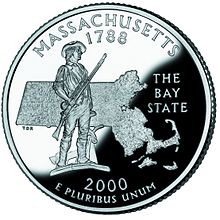Minutemen

Minutemen is a name given to members of the militia of the American Colonies, who vowed to be ready for battle in a minute's notice.
The term minutemen has also been applied to various later United States' military units to recall the success and patriotism of the originals.
History
As early as 1645 in the Massachusetts Bay Colony, some men were selected from the general ranks of town-based "training bands" to be ready for rapid deployment. Minutemen were usually drawn from the few original settlers of each town, and so it was very common to be fighting alongside cousins and in-laws.
Some towns in Massachusetts had a long history of designating a portion of their militia as Minutemen, but others preferred to keep their entire militia in a single unit. After The Powder Alarm in the fall of 1774, Patriot leaders in the newly formed Massachusetts Provincial Congress recommended that all militias contain minute companies—special units within the militia system whose members underwent additional training and to hold themselves ready to turn out quickly ("at a minute's notice") for emergencies. Some towns followed this recommendation and altered their unit structures, but some took no action.
The Minutemen were usually 25 years old or younger, and they were chosen for their enthusiasm, reliability, and strength. They were the first armed militia to arrive or await a battle. Officers were elected by popular vote, and each unit drafted a formal written covenant to be signed upon enlistment. They typically assembled four times per year for training during peacetime. It was common, sometimes even in the middle of battle, for officers to make decisions through consultation with their men as opposed to giving orders to be followed without question.
Motivation

The New England town meeting style of local decision-making in combination with the colonial legislature meant that, for nearly all functions of government, these men had already experienced generations of self-rule. Even though most of them could not express lofty sentiments about the rights of man and the purposes of government, they knew that the same British Army of professional soldiers who had once fought with them against a common enemy was now in their land to take something important away from them. One Massachusetts man used the phrase "An Englishman's home is his castle" when he explained to his friends why he had barricaded himself behind his front door to fight the British Army as it passed by during the final phase of the Battle of Lexington and Concord. The typical individual American Patriot in Massachusetts fought for a political idea even at this first stage of the war when independence from Great Britain was not yet a common sentiment.
Equipment, training, and tactics

Most Colonial militia units were provided neither arms nor uniforms and had to equip themselves. Many simply wore their own farmers' or workmans' clothes, while others had buckskin hunting outfits. Some added Indian-style touches to intimidate the enemy, even including war-paint. Most used hunting rifles, which did not have bayonets but were accurate at long range.
The Continental Army regulars received European-style military training later in the American Revolutionary War, but the militias did not get much of this. Rather than fight formal battles in the traditional dense lines and columns, they were better when used as irregulars, primarily as skirmishers and sharpshooters.
Their experience suited irregular warfare. Most were familiar with frontier hunting. The Indian Wars, and especially the recent French and Indian War, had taught both the men and officers the value of irregular warfare, while many British troops fresh from Europe were less familiar with this. The wilderness terrain that lay just beyond many colonial towns, very familiar to the local minuteman, favored this style of combat.
The rifled musket used by most minutemen was also well suited to this role. The rifling (grooves inside the barrel) gave it a much greater range than the smoothbore musket, although it took much longer to load. Because of the lower rate of fire, rifles were not used by regular infantry but were preferred for hunting. When performing as skirmishers, the minutemen could fire and fall back behind cover or other troops before the British could get into range. The increased range and accuracy of the rifle, along with a lifetime of hunting to develop marksmanship, earned minutemen sharpshooters a deadly reputation.
Ammunition and supplies were in short supply and were constantly being seized by British patrols. As a precaution, these items were often hidden or left behind by minutemen in fields or wooded areas. Other popular concealment methods were to hide items underneath floorboards in houses and barns.
Legacy

In commemoration of the centenary of the first successful armed resistance to British forces, Daniel Chester French, in his first major commission, produced one of his best-known statues (along with the Lincoln Memorial), the Concord Minuteman. Inscribed on the pediment is the opening stanza of Ralph Waldo Emerson's 1837 Concord Hymn with the immortal words, "Shot heard 'round the world." The statue's likeness is based on Isaac Davis, the Captain of the Acton Militia and first to be killed in Concord during the Battle of Lexington and Concord on April 19, 1775.
References
- Paul Revere's Ride by David Hackett Fischer ISBN 0-19-508847-6
- The Encyclopedia of Military History, from 3500 B.C. to the Present by R. Erniest Dupuy and Trevor N. Dupuy ISBN 0-06-270056-1
- This article incorporates text from a publication now in the public domain: Chisholm, Hugh, ed. (1911). Encyclopædia Britannica (11th ed.). Cambridge University Press.
{{cite encyclopedia}}: Missing or empty|title=(help)
